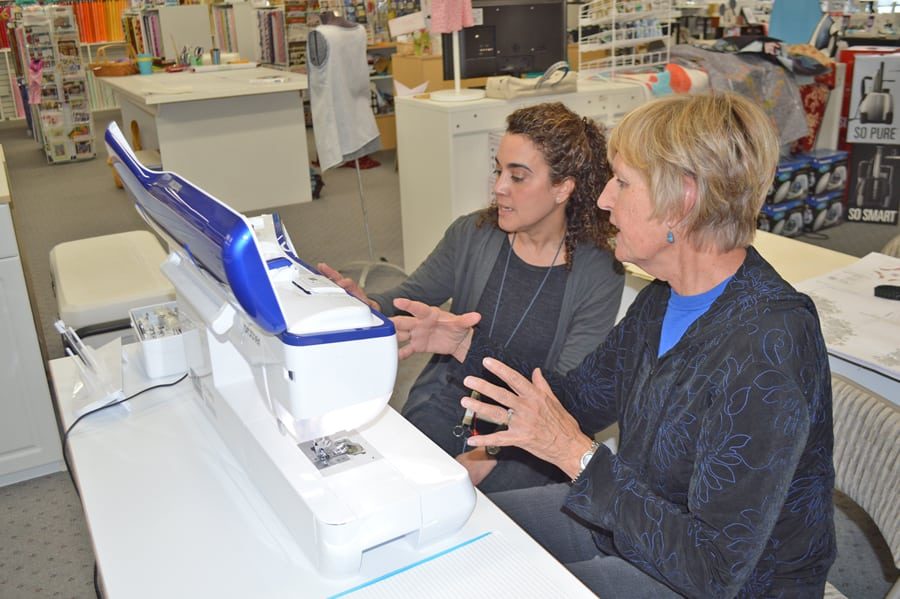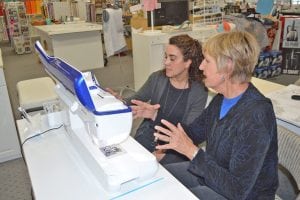
Home » Technology stitches solid future for downtown Kennewick store
Technology stitches solid future for downtown Kennewick store

June 15, 2017
By Robin Wojtanik
The transformation of sewing from a mother’s necessity to a high-tech hobby has kept Sandy’s Fabrics and Machines in business for 40 years.
Today, most sewing projects have moved beyond garment making but Sandy’s shows no sign of slowing. The downtown Kennewick store is filled with computers that use a needle and thread. Shop owner Karen Jarrett pointed to a machine on a nearby table retailing for $15,000.
Jarrett has many customers who own more than one of these devices. It’s all part of a new breed of sewers, which include a wide range of hobbyists and entrepreneurs, children and seniors.
Sandy’s has remained relevant and successful at its location at 24 N. Benton St. by adjusting as the industry changed. Sandy’s Fabrics opened in 1977 and expanded to machines in 1981.
Jarrett said the watershed moment happened in 1994 when machines that could embroider came on the market.
“It was like going from the rotary phone to the iPhone,” recalled Jarrett.
Prior to that, Jarrett said the industry hadn’t changed much.
She discovered these new machines bred a new interest in the craft, and her original store in Bend, Oregon, adapted right along with it.
Owning a machine and fabric store was a natural fit for Jarrett. “There wasn’t a time in my life where there wasn’t a (sewing) machine in my house,” she said.
She learned to sew from her mother, and when she and her husband decided to explore owning a business, they visited the three sewing machine stores in Bend.
They made an offer to one of the owners and within two to three years, a deal was in place. Years later the couple bought a second store there and combined the two under one roof.
Jarrett said the sewing industry is small enough that she knows everyone in business west of the Rockies. Because of these connections, Ed and Karen Jarrett were some of the first to learn when Sandy’s Fabrics and Machines was for sale in 2012. They bought the business from Frank and Sandy Votaw and kept its original name and location.
The Votaws can still be found at the business they started in 1977. When the Jarretts take time off, Sandy works the retail counter and Frank fills in on machine servicing.
The ownership change hasn’t affected customer loyalty. One longtime customer is Peggy Kannberg, who is at the shop so often, she joked, “Sometimes I think I should move in.”
Kannberg has been coming to Sandy’s since it opened in the early ’80s, and currently owns three machines she bought from the store. She said sewing has always been a hobby, after first learning the craft in a home economics class.
Kannberg is one of the hobbyists who didn’t learn to embroider until the technology changed in the mid-90s. She said she continues to try out new techniques for embroidery. “It’s a good way to keep up with technology. It stretches your brain,” she said.
Like Kannberg, Jarrett’s core customer base is retired and use the machines purely for hobby. But Jarrett said the increasing popularity to monogram or personalize items has resulted in local entrepreneurs taking on small projects — for weddings or family reunions — typically overlooked by larger embroidery companies who prefer orders in the hundreds.

Jarrett pointed to a 10-thread embroidery machine costing about $20,000. She said she has known a number of customers who bought the machine, started a small business and managed to pay off the machine and draw a profit in less than a year.
Embroidery and quilting remain some of the most popular crafts among Sandy’s customers. Jarrett said the act of garment-making nearly died out completely after it became increasingly possible to buy inexpensive clothes.
Now, she sees the hobby making a comeback. With three millennials on staff, Jarrett said younger customers are being drawn into sewing and embroidery as well. The younger generation is often less traditional when it comes to quilting, and tends to gravitate toward appliques, monograms and personalized gift items.
Jarrett said new sewers aren’t learning the craft from a parent or grandparent either. She said these beginning sewers are more likely to be self-taught using online courses or watching how-to videos on YouTube.
For those looking to pick up the hobby, improve their skills, or graduate to new technology, Sandy’s offers a wide array of classes and includes training in the purchase of a machine.
Kannberg attends classes twice a month, on average.
“Coming here is a big inspiration. You see something in the store and you are interested in a class to learn how to do it or how to make it.”
Classes include everything from how to use a machine and specific software to creating a project and improving techniques.
Kannberg said she appreciates the creative process of sewing and embroidery.
“You look at something and go, ‘I could do that,’ and you figure out how to do it,” she said.
Sandy’s keeps its website, sandysfabrics.com, current with a list of available classes and special events. The store recently hosted an instructor from Australia who came to Sandy’s first on a nationwide American tour called, “The Sewing Revolution.”
Another recent event focused on machine embroidery by Kimberbell. Sandy’s also will feature an event on machine software in July, and its annual quilting event is held off-site in October, with each attendee going home with four full projects.
Sandy’s also offers classes and a summer camp for children, with a suggested starting age of 8 years old.
Jarrett prides herself in keeping current with the industry, continually learning new techniques to share with customers.
A Zentangle quilt Jarrett created hangs on the wall of her shop includes embroidery, decorative stitches, plus pen and ink, but other designs may include doodling or scribbling to create art. She appreciates the challenge of trying something new and sees this frequently in her customers.
Jarrett said she sees many retired engineers, including men, who find the hobby keeps them engaged, especially embroidery.
Customers remain intrigued by the technology of today’s machines, which may include software costing $4,000.
Sandy’s also sells machines that connect to mobile apps on a smartphone or tablet, and ones that prompt the user to download a software update when the machine is turned on. Referencing accounts in the cloud for sewing and embroidery patterns, Jarrett recalled an era when some of her customers bought a computer for the first time, just to sync it with their sewing or embroidery machine.
Today’s machines can complete a project with no human intervention once programmed by the user. For traditionalists who consider this “cheating,” Jarrett offered the comparison of using a pocketknife versus chainsaw when tasked with chopping wood.
For those interested in taking up the hobby, Sandy’s displays the inside of a typical inexpensive sewing machine purchased at a big box or online retailer versus one sold at the downtown Kennewick store.
It’s a visual reminder to customers: “you get what you pay for.” The inexpensive machine found online is mostly made of plastic, versus the steel core found in models sold exclusively by machine distributors, like Sandy’s.
The shop also takes used machines on trade, and makes them available for resale. New machines for beginners cost about $200 and include a two-part workbook class that teaches the buyer how to use it.
Together with her daughter, Elizabeth, Jarrett said she hopes to keep introducing sewing and embroidery techniques to those looking for a new skill.
Sandy’s Fabrics and Sewing can be reached at 509-585-4739 and found online at sandysfabrics.com or on Facebook.
Business Profiles Local News
KEYWORDS june 2017





